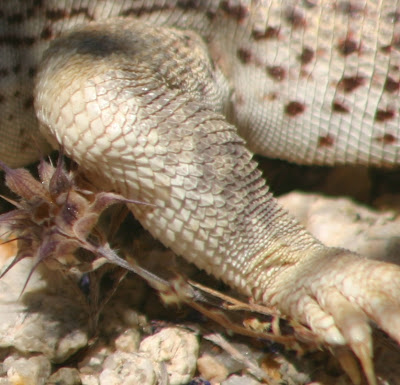I recently saw two desert iguanas
while hiking near the Hayfield Road exit off I-10, on the bajada on the edge of the Eagle Mountains.
The Wikipedia article says the desert iguana is "one of the most common lizards of the Sonoran and Mojave deserts."
I heartily disagree. I was in the same area seven times last year, and once earlier this year, and these are the first desert iguanas I've seen.
I've seen more leopard lizards, chuckwallas, yellow-backed spiny lizards, whiptails and zebra-tailed lizards. In quite a few trips to Organ Pipe Cactus National Monument I've not seen any desert iguanas. The only place I've seen them previously were in the Desert Tortoise Refuge near California City, one in the Mecca Hills and one running across the freeway near Corn Springs. They are amazingly fast.
If they run, you have absolutely no chance of keeping up with them.
They are also wary, and generally do not let you get close to them.
Fortunately, the first desert iguana I saw allowed me to get relatively close
and I followed it for about 30 minutes and eventually caught it.
The first one I've ever caught, in fact, the first one I've ever gotten a close look at. The desert iguana has a small head with a blunt nose and large ear openings. It has a row of enlarged keeled scales down the middle of its back, which are larger toward the head, forming a crest and going to near the end of the tail.
The other scales
are smaller and granular.
It has a long tail, often 1 1/2 times the length of the rest of the body. It is beige or gray with reddish-brown markings.
They can tolerate higher daytime temperatures than any other North American reptile, up to about 115 degrees. They eat leaves, flower buds and flowers,
often climbing branches of the creosote bush (it is particularly attracted to its yellow flowers) and other plants.
I saw this desert iguana eat both green leaves and some flowers while I watched it.
They will also eat insects and carrion. It is usually found in sandy habitat, along rocky stream beds
and bajadas.
Its range is very close to that of the creosote bush, one of its staple foods. It is found in southeastern California, southern Nevada, portions of southwestern and southcentral Utah, western Arizona and down into Mexico, along both sides of the Gulf of California down to about the tip of the Baja Peninsula.



















Do you normally write for your domain or maybe for some other online or offline portals?
ReplyDeleteNo, this blog is my only form of on-line writing.
DeleteDesert Iguanas can be found in the day hours between 9 a.m. and 2 p.m. at low altitude below 3000 ft. around the creosote plant of the Mojave and Sonoran desert air temperature must be 90 degrees and above.
ReplyDelete